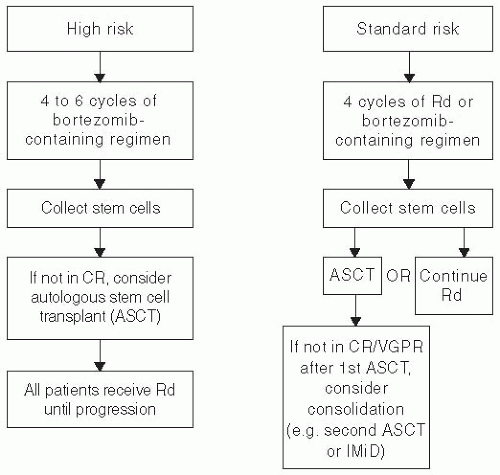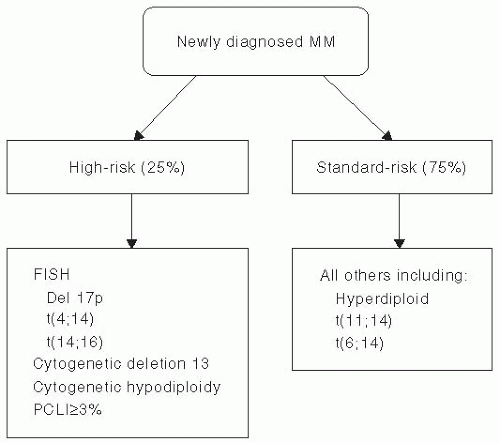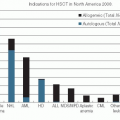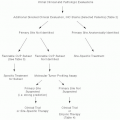Regimen |
Authors Preferred Dosing Schedulea |
Melphalan-Prednisone (7-d schedule) |
Melphalan 8-10 mg oral days 1-7
Prednisone 60 mg/d oral days 1-7
Repeated every 6 wk |
Thalidomide-Dexamethasoneb |
Thalidomide 200 mg oral days 1-28
Dexamethasone 40 mg oral days 1, 8, 15, 22
Repeated every 4 wk |
Lenalidomide-Dexamethasone |
Lenalidomide 25 mg oral days 1-21 every 28 d
Dexamethasone 40 mg oral days 1, 8, 15, 22 every 28 d
Repeated every 4 wk |
Bortezomib-Dexb |
Bortezomib 1.3 mg/m2 intravenous days 1, 8, 15, 22
Dexamethasone 20 mg on day of and day after bortezomib (or 40 mg d 1, 8, 15, 22)
Repeated every 4 wk |
Melphalan-Prednisone-Thalidomide |
Melphalan 0.25 mg/kg oral days 1-4 (use 0.20 mg/kg/d oral days 1-4 in patients over the age of 75)
Prednisone 2 mg/kg oral days 1-4
Thalidomide 100-200 mg oral days 1-28 (use 100 mg dose in patients >75)
Repeated every 6 wk |
Bortezomib-Melphalan-Prednisoneb |
Bortezomib 1.3 mg/m2 intravenous days 1, 8, 15, 22
Melphalan 9 mg/m2 oral days 1-4
Prednisone 60 mg/m2 oral days 1-4
Repeated every 35 d |
Bortezomib-Thalidomide-Dexamethasoneb |
Bortezomib 1.3 mg/m2 intravenous days 1, 8, 15, 22
Thalidomide 100-200 mg oral days 1-21
Dexamethasone 20 mg on day of and day after bortezomib (or 40 mg days 1, 8, 15, 22)
Repeated every 4 wk × 4 cycles as pre-transplant induction therapy |
Cyclophosphamide-Bortezomib-Dexamethasoneb (CyBorD) |
Cyclophosphamide 300 mg/m2 orally on days 1, 8, 15, and 22
Bortezomib 1.3 mg/m2 intravenously on days 1, 8, 15, 22
Dexamethasone 40 mg orally on days 1, 8, 15, 22
Repeated every 4 wkc |
Bortezomib-Lenalidomide-Dexamethasoneb |
Bortezomib 1.3 mg/m2 intravenous days 1, 8, 15
Lenalidomide 25 mg oral days 1-14
Dexamethasone 20 mg on day of and day after bortezomib (or 40 mg days 1, 8, 15, 22)
Repeated every 3 wkd |
a All doses need to be adjusted for performance status, renal function, blood counts, and other toxicities.
b Doses of dexamethasone and/or bortezomib reduced based on subsequent data showing lower toxicity and similar efficacy with reduced doses.
c Omit day 22 dose if counts are low or when the regimen is used as maintenance therapy; When used as maintenance therapy for high-risk patients, delays can be instituted between cycles.
d Omit day 15 dose if counts are low or when the regimen is used as maintenance therapy; When used as maintenance therapy for high-risk patients, lenalidomide dose may be decreased to 10-15 mg per day, and delays can be instituted between cycles as done in total therapy protocols. |
Reproduced from Rajkumar SV. Multiple myeloma: 2011 update on diagnosis, risk-stratification, and management. Am J Hematol. 2011;86(1):57-65. |








